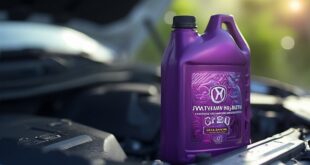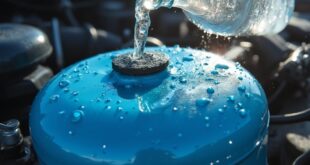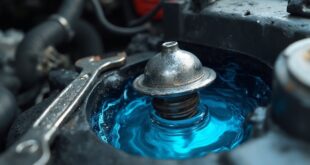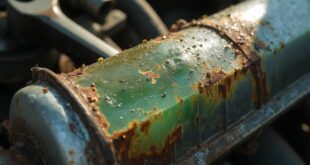If your car's leaking water, it could be due to several reasons. Common causes include condensation from your air conditioning, recent rain, or coolant leaks. The fluid's color can help you identify the source; clear usually means AC or rainwater, while blue suggests windshield washer fluid. It's important to pinpoint the leak's origin for proper maintenance. Stay tuned to uncover more about potential cabin leaks and how to tackle them effectively.
Common Causes of Water Dripping From Underneath Your Car
Water dripping from underneath your car can be a common occurrence, and it's essential to understand the reasons behind it.
One common cause is your air conditioning system, where moisture drains out as it cools the cabin. If you've recently driven in the rain or washed your car, pooling water may also drip from the chassis.
Exhaust condensation can create water droplets as the system cools, too.
Finally, check for any leaks from windshield washer fluid, which typically has a blue tint.
Identifying these causes helps you stay informed about your vehicle's condition.
How to Identify and Assess the Leak
When trying to figure out what's leaking from your car, the first step is to determine the fluid's color. This can help you identify whether it's just water or something more concerning.
Here's a quick guide:
- Clear: Likely just water from your AC or rain.
- Blue: Indicates windshield washer fluid.
- Green/Orange/Yellow: Suggests a coolant leak.
- Brown/Black: Points to oil or brake fluid.
To assess the severity, place cardboard under the leak to catch the fluid.
If it's colored, it's best to inspect further to avoid potential damage.
Potential Causes of Water Leaks Into the Cabin
Have you ever wondered why your car's interior feels damp or musty? Several factors could be causing those annoying water leaks. Here's a quick overview of potential culprits:
| Cause | Symptoms | Solution |
|---|---|---|
| Clogged Evaporator Drain | Water pooling in the cabin | Clean the drain |
| Damaged Heater Core | Cold cabin, sweet smell | Replace heater core |
| Leaking Windows/Sunroof | Visible water intrusion | Inspect and reseal |
| Blocked Drainage Channels | Water overflow in the cabin | Regular maintenance |
Identify the source to keep your cabin dry and comfortable!
Steps for Repairing Water Leaks
Identifying the source of a water leak is essential for effective repair, as it allows you to address the root cause and prevent further damage.
Start by checking the leak location and fluid type. Follow these steps for repairs:
- Place cardboard under the leak to identify the fluid.
- Fix any damaged seals or drainage issues.
- Replace malfunctioning parts, prioritizing interior leaks.
- Test your repairs by monitoring for leaks after fixing.
Stay vigilant and check for leaks regularly to guarantee your car remains water-tight and functioning properly.
The Importance of Professional Assistance
Even after following the steps for repairing water leaks, some issues may require a level of expertise that goes beyond DIY fixes. Seeking professional assistance guarantees that you address the root cause of the problem effectively. Mechanics can diagnose complex issues that may not be apparent to you, preventing further damage.
| Benefits of Professional Help | DIY Limitations |
|---|---|
| Accurate diagnosis | May overlook hidden issues |
| Specialized tools and knowledge | Lacking experience |
| Warranty on repairs | No guarantees |
| Saves time and hassle | Time-consuming troubleshooting |
Preventative Measures to Avoid Water Leaks
To prevent water leaks in your car, regular maintenance is key. By staying proactive, you can avoid potential issues down the road.
Here are some vital steps to keep in mind:
- Regularly inspect seals and gaskets for wear and replace them if necessary.
- Clean drainage areas to guarantee proper water flow and prevent clogs.
- Monitor fluid levels to identify any drops before they lead to leaks.
- Be mindful of driving conditions, avoiding deep water or heavy rain whenever possible.
Taking these measures can help keep your car dry and functioning well for years to come.
Monitoring and Ongoing Vigilance for Leaks
While you've taken steps to repair any leaks in your car, staying vigilant afterward is essential to guarantee they don't return.
Regularly inspect the areas where leaks occurred, using cardboard to catch any dripping fluids. Pay attention to changes in your vehicle's performance or unusual smells, as these can signal a new issue.
Make it a habit to check your fluid levels and watch for any signs of dampness in the cabin. If you notice anything suspicious, don't hesitate to consult a mechanic.
Ongoing vigilance is key to keeping your car leak-free and functioning properly.
Frequently Asked Questions
Can I Drive My Car if It's Leaking Water?
If your car's leaking water, assess the situation first. If it's just condensation from the AC or rainwater, you can drive it. However, if it's colored fluid, get it checked immediately for potential issues.
How Can I Tell if a Leak Is Serious?
You can tell if a leak is serious by checking the fluid color. Clear indicates water, while colored fluids may signal significant issues. Monitor the leak's location and seek professional help if needed.
Will Water Damage My Car's Interior?
Yes, water can damage your car's interior if it seeps into upholstery or electronics. Mold can develop, and components may corrode. It's essential to address leaks promptly to prevent lasting damage to your vehicle.
Is It Safe to Park Under Trees to Avoid Leaks?
Parking under trees can shield your car from rain, but it might expose you to falling branches and sap. You should weigh the pros and cons, ensuring your car stays safe and damage-free.
How Often Should I Check for Leaks?
You should check for leaks regularly, ideally every month or after heavy rain. Inspect your vehicle's seals, drainage areas, and fluid levels to catch potential issues early and maintain your car's performance.
 Car Service Land Coupons for Oil change, Tires, Wheel alignment, Brakes, Maintenance
Car Service Land Coupons for Oil change, Tires, Wheel alignment, Brakes, Maintenance




